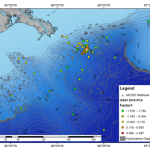What criteria makes Gulf seafood “safe to eat”?
In part 2, we’re geting down to the nitty gritty: what guidelines and criteria are the FDA and NOAA using to approve the sale and consumption of seafood from the Gulf of Mexico?
The FDA is currently focusing its tests on two separate compounds: PAHs (Polycyclic Aromatic Hydrocarbons) to test for the presence of crude oil, and DOSS (Dioctyl Sodium Sulfosuccinate) to test for dispersants. [This post will cover PAHs, and my next post will cover DOSS]. The detection of crude oil is undertaken in two stages–first, those notorious ‘sniff tests’ (sorry, sensory testing, dahhhhling) to detect potentially contaminated seafood, and second, chemical testing to elucidate the exact concentrations of individual petroleum compounds. eXtension offers a detailed rundown of the procedure:
The first line of screening is the sensory evaluation of aroma. Field screeners can detect down to 10 ppm of PAHs.Samples that fail the smell test are submitted to NMFS for testing by an expert panel. Experts can detect PAHs to a level of 0.5 ppm. This amount is similar to a pinch (0.010 or 10 milligrams) of salt in a liter of water (about five cups) [NB: also equivalent to a drop of oil in one gallon of water]. Positives are subdivided with half subjected to sensory evaluation of cooked flavor and the other half is sent to the Seattle NMFS lab for testing.
Chemical analysis is conducted to determine whether seafood tissues are contaminated with petroleum compounds. Detailed analysis typically is conducted using gas chromatography and mass spectrometry. Individual PAHs at very low detection levels are measured to provide a PAH pattern that can be compared to that of the source oil. The quantitative results for specific PAHs can be used to assess whether the detected levels pose a risk to human health through seafood consumption. Results from detailed analysis may take up to two weeks to be obtained.
So what you might not realize is that a tested sample may only have been evaluated for smell and taste. Only the funky smelling ones get sent off for that further chemical analysis. Now I’m not knocking the expert olfactory senses, but do we know enough about these compounds to be sure that we can definitely smell them? The NOAA publication “Managing Seafood Safety after an Oil Spill” notes that:
In that we are not certain which compounds in petroleum are responsible for taint perceived by humans, chemical analysis cannot yet substitute for sensory testing in determining whether a taint is present. It has been suggested that the principal components of crude and refined oils responsible for tainting include the phenols, dibenzothiophenes, naphthenic acids, mercaptans, tetradecanes, and methylated naphthalenes (GESAMP 1977). The human olfactory system generally is very sensitive to phenolic and sulfur compounds, even though they are minor components of oil.
So logically, shouldn’t there be some compounds that don’t smell but are chemically present (and potentially carcinogenic)? PAHs constitute a wide class of chemicals, so perhaps only a few of those are responsible for distinctive petroleum smells.
After testing, government regulators have to make a decision as to whether seafood is safe or not safe for general consumption. This is done using a standard ‘Level of Concern’ for human health risk, calculated based on a suite of factors: a person’s weight, how much seafood they consume, their age, and the predicted length of chemical exposure. This level for PAHs varies by species, and for Gulf seafood tests the numbers are as follows: 61.5 ppm for shrimp/crabs, 66.5 ppm for oysters, and 16.35 ppm for fish (as noted on testing result spreadsheets). In the areas currently open for fishing, all species have tested bellow this level of concern for PAHs. This sounds great, until you look at the numbers from the NOAA memos:
…the Food and Drug Administration (FDA) has concluded that the conditions for reopening specified in our agreed upon reopening protocol have been met for finfish (areas CIO-12) and shrimp (area C-11 only)…Compositing of like species from like sample locations resulted in 13 separate samples (10 finfish and 3 shrimp) for PAH analysis…PAH levels in all samples are significantly below the levels of concern established in the reopening protocol, which was agreed upon by NOAA and FDA.
Another memo from testing in June-July noted that “All 24 requested crab samples were collected. Fourteen of 16 shrimp samples were collected and 11 of 16 oyster samples were collected.” Note that one NOAA grid area is 30 nautical miles (~40 square miles). That’s TWICE the size of Manhattan. So according to the block quote from the first memo, 5 shrimp over an area 6 times the size of Manhattan = your Gulf seafood is safe, hurrah!
So here comes my rant.
1) WTF is with the low numbers of seafood being tested?!? Rule #1 in scientific studies is to have a large, statistically significant sample size. Sample sizes <30 for large swathes of the Gulf of Mexico is NOT empirically rigorous. I suspect that the limited testing is related to cost—chemical analysis isn’t cheap, with gas chromatography and mass spectrometry analysis running up to $750 per sample. However, usually a much cheaper approach is used to screen samples for potential contamination—methods like high performance liquid chromatography with fluorescence detection (HPLC/florescence), which NOAA has clearly been using on samples. Theroetically, BP should be covering the cost for all this screening anyway so in my opinion there really is no excuse.
2) Cookie cutter statistics–the way in which NOAA has determined their ‘Level of Concern’ (LOC) for human health risk is a bit dodgy. I know they need some sort of metric, but as the media has been reporting, Gulf coast residents eat a LOT of seafood. FDA tests clearly show PAHs in Gulf seafood, but they get a safe stamp because these levels fall below the national average LOC. However, a recent survey by the Natural Resources Defense Council estimates that Gulf residents eat much more than the national average (3-12 times as much seafood), with many respondents (60%) nothing that they weigh less than the FDA’s assumed weight and have risk-groups at home (e.g. children-40%) who also eat seafood. Also, FDA tests only test the actual flesh of shrimp, crabs, and oysters–many people in the gulf use the shells and organs in cooking, and anecdotal reports from consumers suggest that something just isn’t looking right. Even if you don’t live in the Gulf coast, you may eat a lot more seafood than the FDA assumes for its LOC (per month: nine 50z fish meas, four meals of four shrimp each, and about three 4.2 oz oyster meals). Who eats four shrimp per meal? For your further perusal, Dr. Gina Solomon offers an empassioned blog post on this topic.
Ironically, as I am finishing up this post my mother walks through the door with 2 pounds of shrimp for Christmas eve hors d’oeuvres. I’m not sure I’m hungry anymore.
References:
Yader, R., Michel, J., & Lord, C. (2002). Managing Seafood Safety after an Oil Spill Seattle: Hazardous Materials Response Division, Office of Response and Restoration, National Oceanic and Atmospheric Administration.http://response.restoration.noaa.gov/book_shelf/963_seafood2.pdf
FDA protocol for Gulf of Mexico Seafood testing: http://www.fda.gov/Food/ucm217601.htm






3 Replies to “Seafood Safety, Part 2a: ‘safe’ criteria, PAHs”
Comments are closed.